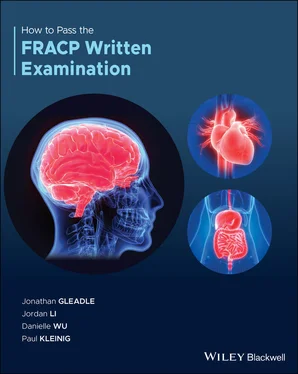https://www.nejm.org/doi/full/10.1056/NEJMra1505550
8. Answer: D
Diabetic nephropathy (DN) is the most common cause of end stage kidney disease in developed countries and is associated with increased cardiovascular morbidity and mortality.
Intensive glycaemic control can reduce the incidence and progression of DN in type 1 diabetes, and this benefit can persist even if the patient subsequently returns to suboptimal glycaemic control, termed the ‘legacy’ effect.
In patients with type 2 diabetes, several studies showed that intensive blood glucose control reduced the relative risk of developing microalbuminuria or worsening of albuminuria by 30–35% when compared to conventional control. However, mortality rates were not reduced or higher in one study in the intensive control group. This may be higher occurrence of significant hypoglycaemia, weight gain, increased use of medications of different classes, and higher use of insulin.
ACE inhibitors and ARBs have similar renoprotective effects in patients with DN but ACE inhibition has been shown to have superior cardiac benefits. Therefore, if a patient has DN and CCF, they should be treated with an ACE inhibitor in preference to an ARB.
The renoprotective effect of an ACE inhibitor or ARB is dose‐related. If the medication is tolerated well the dose should be gradually increased to the maximum recommended dose. An initial 10% reduction in eGFR before plateauing is common after the commencement of ACE inhibitor or ARB and the drug should be continued unless there is further reduction of eGFR.
Dual renin–angiotensin–aldosterone system (RAAS) blockade with both ACE inhibitor and ARB has shown a superior antiproteinuric effect compared to monotherapy with either agent, but the effect on slowing DN progression is unknown. Significant rates of serious adverse events; including AKI, hyperkalaemia and need for dialysis were observed with dual therapy in the ONTARGET, ALTITUDE and VA‐NEPHRON D trials with no significant benefit. Therefore, dual therapy is not currently recommended.

Umanath K. Update on diabetic nephropathy: Core Curriculum 2018. Am J Kidney Dis. 2018;71:884–95. https://www.ajkd.org/article/S0272-6386(17)31102-2/fulltext
9. Answer: B
Diabetic ketoacidosis (DKA) is a life‐threatening complication of type 1 diabetes. It can also occur in patients with type 2 diabetes and is known to occur in patients taking SGLT2 inhibitors; in this situation, blood glucose may not be elevated. In its classical form, DKA is a complex disordered metabolic state characterised by ketonaemia, hyperglycaemia, and metabolic acidosis. This results from absolute or relative insulin deficiency accompanied by an increase in counter‐regulatory hormones (glucagon, epinephrine, cortisol, growth hormone). DKA is often triggered by other medical or surgical conditions such as sepsis and is associated with significant morbidity and mortality. Therefore, it must be diagnosed promptly and managed intensively.
The diagnostic criteria of DKA include:
1 Blood ketones ≥3 mmol/L or urine ketones ≥2+ on dipsticks.
2 Blood glucose >11 mmol/L or known diabetes.
3 Bicarbonate (HCO3‐) <15 mmol/L and/or venous pH <7.3.
The goals of treatment for DKA include:
Restoration of circulatory volume.
Clearance of ketones.
Correction of electrolyte losses (mainly hypokalaemia).
Normalisation of blood glucose and prevention of hypoglycaemia.
Prevention of other potential complications such as cerebral oedema, venous thromboembolism (VTE), and sepsis.
Intravenous 0.9% sodium chloride solution is the principal fluid to restore circulating volume and reverse dehydration. The first litre is administered over 1 hour. If the systolic BP remains <90 mmHg, 500 mL should then be administered over 15 min and reassessed. Caution should be exercised in the elderly or patients with CCF where too rapid rehydration may precipitate pulmonary oedema, but insufficient fluid resuscitation may fail to reverse AKI. Regular reassessment of cardiovascular status is mandatory.
| Bag number |
Time (hr) |
Fluid |
Infusion rate |
Potassium replacement |
| 1 |
0–1 |
0.9% sodium chloride |
1000 ml/hour |
May be required if >1000 ml of fluid has been given due to hypotension |
| 2 |
1–3 |
0.9% sodium chloride |
500 ml/hour |
Monitor potassium level & replace with IV potassium chloride as per table below |
| 3 |
3–5 |
0.9% sodium chloride |
500 ml/hour |
| 4 |
5–9 |
0.9% sodium chloride |
250 ml/jour |
| 5 |
9–13 |
0.9% sodium chloride |
250 ml/hour |
| 6 |
13–19 |
0.9% sodium chloride |
166 ml/hour |
| Potassium level in first 24hrs (mmol/L) |
Potassium replacement |
| >5.5 |
Nil |
| 3.5–5.5 |
30 mmol |
| <3.5 |
ICU admission, replacement 10 mmol/L/hr |
Intravenous insulin infusion with Actrapid should be started as soon as possible and boluses of insulin should be avoided unless there is significant delay (≥1 hour) in setting up an insulin infusion. Insulin infusion should not be stopped until the patient is eating and drinking normally and ketones <0.3 mmol/L, venous pH >7.35, and the patient has received a bolus of long‐acting subcutaneous insulin as part of transition to subcutaneous basal bolus insulin regimen.
Sodium bicarbonate should not be administered in patients with DKA unless the arterial plasma pH falls below 7. However, this decision should be individualised. Most patients with DKA do not require the administration of sodium bicarbonate, since infused insulin will slow the rate of ketoacid production, and bicarbonate ions will be produced when ketoacid anions are oxidised.

Karslioglu French E, Donihi A, Korytkowski M. Diabetic ketoacidosis and hyperosmolar hyperglycemic syndrome: review of acute decompensated diabetes in adult patients. BMJ 2019;365:l1114
https://www.bmj.com/content/365/bmj.l1114
10. Answer: C
Erectile dysfunction (ED) is defined as persistent inability to achieve or maintain an erection adequate for satisfactory sexual activity. After premature ejaculation, it is the most common disorder of sexual function in men. ED is a natural part of ageing and prevalence increases with age. Due to its effects on blood vessels and nerves systemically and in the penis, diabetes is a common aetiology of ED. Men with diabetes are four times more likely to experience ED, and on average, ED develops 15 years earlier than in men without diabetes. ED and/or decreased libido are common side‐effects of many medications; drugs which can cause this include β‐blockers, hydrochlorothiazides, and SSRIs. The pathogenesis of organic ED is related to dysfunction of the endothelium.
Guidelines recommend screening for low testosterone with a morning total testosterone assay (08.00–11.00 a.m.) in men with ED and hypoactive sexual desire, incomplete response to phosphodiesterase type 5 (PDE5) inhibitors, delayed ejaculation, and in all men with known diabetes. The prevalence of low total testosterone levels in men with ED varies widely across studies and ranges from 12.5% to 35%. The threshold of testosterone to maintain an erection is low (< 5.5 nmol/L) and ED is usually a symptom of more severe cases of hypogonadism. If total testosterone level is ≥ 12 nmol/L, testosterone deficiency is unlikely. If total testosterone is < 12 nmol/L, a second morning venous blood sample drawn after an interval of at least one week, together with serum luteinising hormone and prolactin levels is required.
Читать дальше














